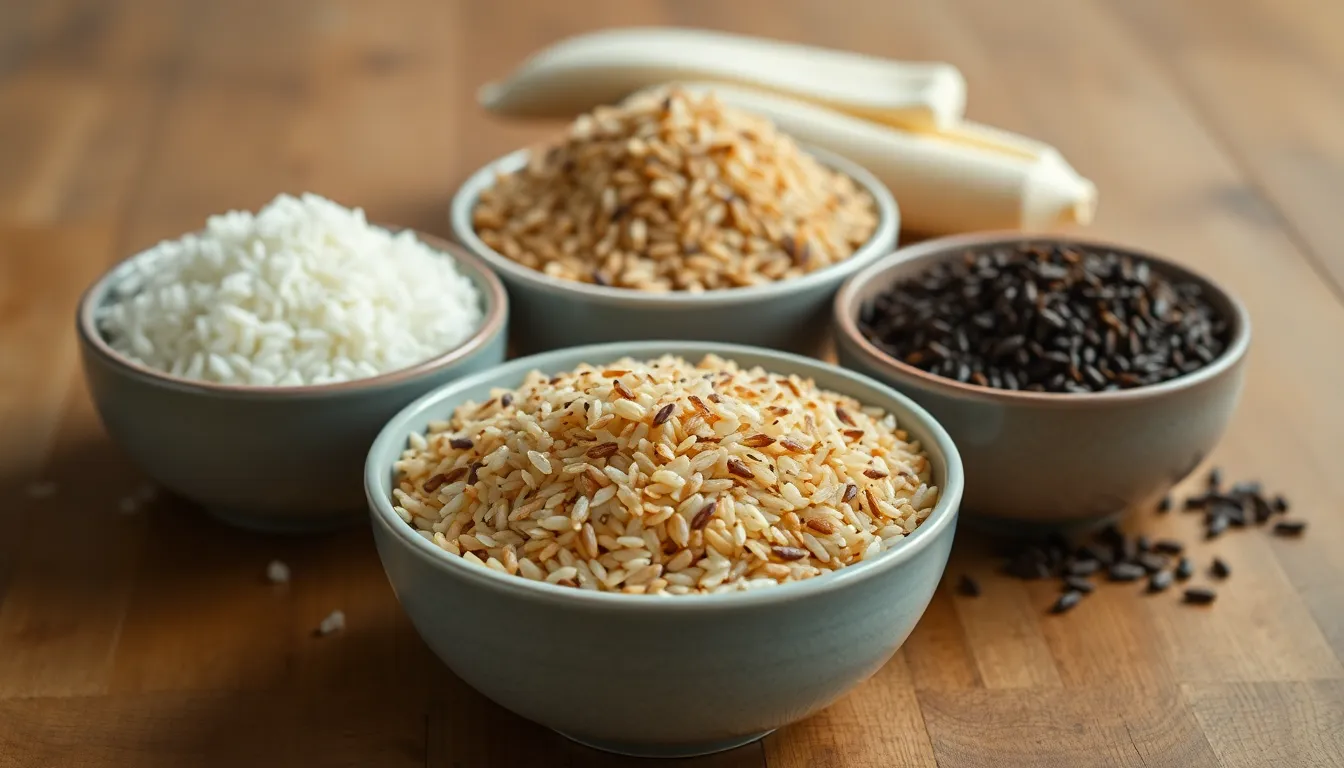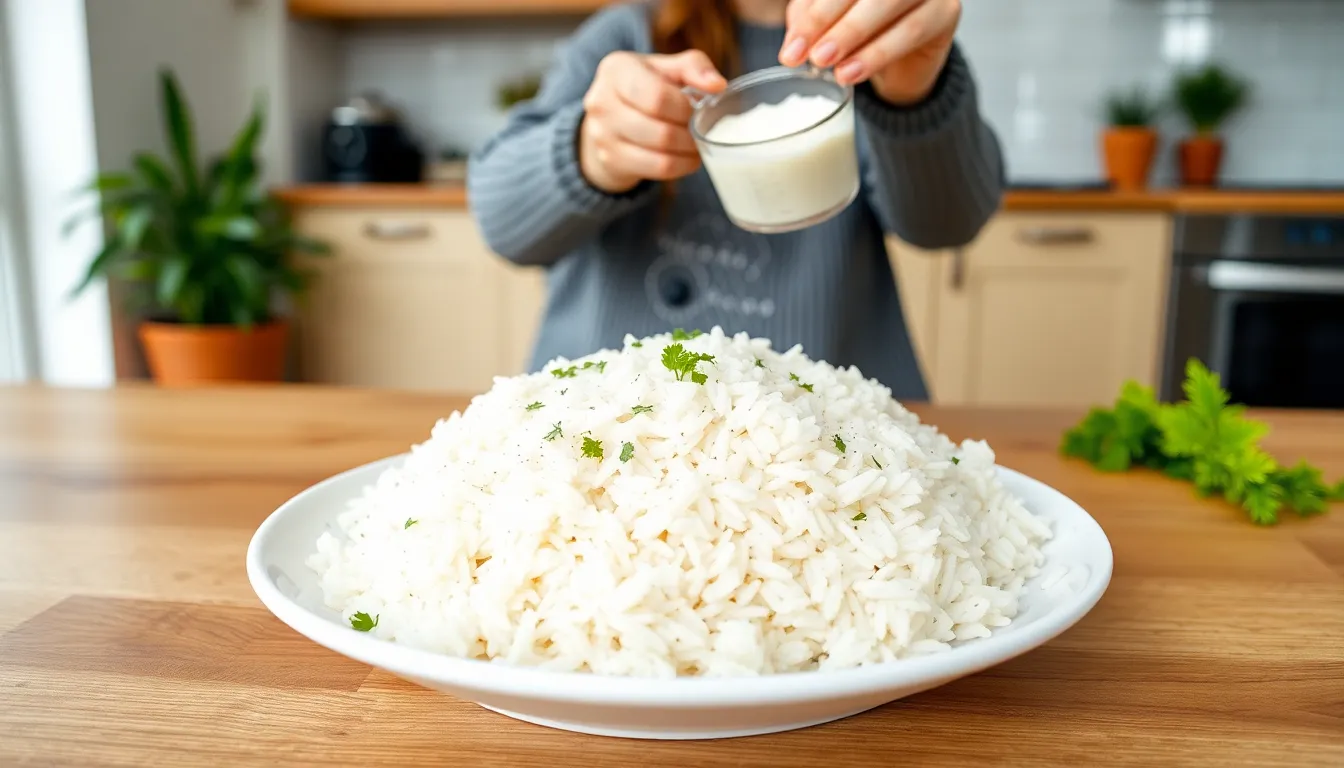Table of Contents
ToggleRice is a staple in many diets around the world, but how much do we really know about its calorie count? Spoiler alert: it’s not just a fluffy sidekick to your stir-fry. Understanding the calorie content of rice can make a big difference in meal planning and portion control.
Overview Of Rice
Rice serves as a fundamental food source for billions worldwide. It contains a variety of types, including white, brown, jasmine, and basmati. Each type varies in calorie content and nutritional value.
Cooked white rice typically holds about 130 calories per 100 grams. Brown rice, often considered more nutritious, provides approximately 111 calories for the same weight. Jasmine rice is quite popular in Asian cuisine, containing roughly 129 calories per 100 grams.
Caloric differences arise from the grain’s processing. White rice undergoes milling, removing the bran and germ, which reduces fiber and nutrients. Brown rice, on the other hand, retains its bran and germ, offering additional vitamins and minerals.
Incorporating rice in a diet can provide energy, with carbohydrates constituting the primary nutrient. Though rice has fewer calories than many other grains, portion control remains important for maintaining balanced meals.
Rice can be paired with various proteins and vegetables, enhancing overall nutrient intake while balancing calorie consumption. Watching portion sizes helps manage caloric intake, especially when rice forms the base of meals.
Whether consumed alone or as part of a dish, knowing how many calories rice contains aids in making healthier food choices. Understanding these values ensures that rice fits well within individual dietary goals and preferences.
Nutritional Composition Of Rice

Rice varies in nutritional composition across its different types, with each offering unique calorie counts and benefits.
White Rice
White rice contains approximately 130 calories per 100 grams. This popular variety provides a quick source of energy because it primarily consists of carbohydrates. During milling, the grain loses much of its fiber and nutrients, making it less nutritionally dense than alternatives. Despite this, white rice remains a preferred choice for many, often served alongside various dishes. Pairing it with proteins and vegetables can enhance its nutritional value and contribute to overall health.
Brown Rice
With roughly 111 calories per 100 grams, brown rice stands out for its higher fiber content. Nutrients such as magnesium and phosphorus also thrive in this whole grain form, making it a more nutritious option than its white counterpart. Its nutty flavor and chewy texture appeal to many health-conscious individuals. Cooking brown rice tends to require longer times than white rice, yet the health benefits often warrant this extra effort in meal preparation.
Basmati Rice
Basmati rice offers about 120 calories per 100 grams, providing a fragrant option for various cuisines. This long-grain rice also contains essential amino acids that contribute to a more balanced diet. Its unique aroma and fluffy texture make it a favorite in dishes like biryani and pilaf. Although slightly higher in calories than some other rice types, basmati rice can still fit well into a calorie-conscious meal plan when portioned appropriately.
Caloric Content Of Rice Varieties
Caloric content varies among rice varieties. Cooked white rice provides approximately 130 calories per 100 grams. Conversely, brown rice offers around 111 calories for the same weight. This difference stems from the processing methods used during milling. White rice loses significant fiber and nutrients, affecting its overall health benefits.
Basmati rice stands out with about 120 calories per 100 grams. A notable feature of basmati rice is its unique aroma and taste, which enhances meals while still being relatively low in calories. Jasmine rice also tends to have a similar caloric profile, typically ranging between 130 and 140 calories per 100 grams, adding flavorful diversity to meals.
Arborio rice, used primarily for risotto, contains about 130 calories per 100 grams when cooked. This creamy texture complements various dishes, but portion size matters for calorie control. Black rice, often termed forbidden rice, delivers around 180 calories per 100 grams. The higher caloric content also brings added nutritional benefits, such as antioxidants and anthocyanins.
Wild rice offers a different nutritional profile with around 101 calories per 100 grams. It provides more protein than other rice types, making it a suitable option for those seeking to increase their protein intake. Hence, choosing rice types carefully allows individuals to align meal choices with dietary goals while managing calorie consumption effectively.
Factors Affecting Caloric Value
Caloric value in rice varies due to several factors, primarily cooking methods and portion sizes.
Cooking Methods
Cooking techniques significantly impact the caloric content of rice. For instance, boiling rice typically maintains its caloric count, while frying rice can significantly increase calories due to added oils or fats. Steaming offers a healthier alternative, helping keep calories lower while preserving nutrients. Cooking rice with additional ingredients like broth or butter also adds calories. Microwaving rice often yields similar results to boiling, allowing for easy meal preparations without sacrificing caloric control.
Portion Sizes
Portion sizes directly influence caloric intake from rice. A standard serving of cooked rice typically weighs about 150 grams, containing approximately 195 calories for white rice. Increasing portion sizes without mindful measurement leads to higher caloric consumption, impacting dietary goals. For those focused on managing calories, measuring rice before cooking is effective. Additionally, pairing rice with protein sources and vegetables can create balanced meals while maintaining portion control.
Understanding the calorie content of rice is crucial for anyone aiming to maintain a balanced diet. With its various types each offering unique nutritional profiles, individuals can make informed choices that align with their dietary goals. By considering cooking methods and portion sizes, it’s possible to enjoy rice while managing caloric intake effectively. When paired with proteins and vegetables, rice can enhance meals, providing energy and essential nutrients. Ultimately, making educated decisions about rice consumption can lead to healthier eating habits and improved overall well-being.







